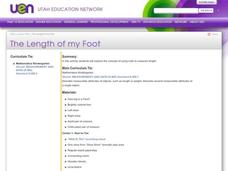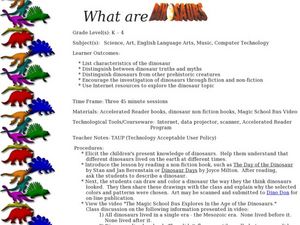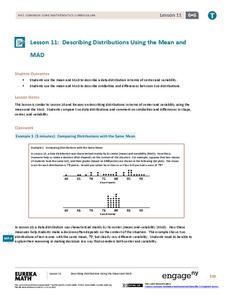Pennsylvania Department of Education
Animal Classes and Their Ecosystems
Students explore animal characteristics by participating in an environment identification activity. In this animal habitat lesson, students discuss a range of different wild life and the ecosystems that they are a part of. Students view...
Curated OER
Attribute Block Shapes
In this math worksheet, students cut out 15 attribute block shapes. The shapes are described as red or blue and include squares, circles, triangles, and hexagons.
Curated OER
Physical Attributes
Practice describing the physical attributes of story characters. After listening to a story, kindergartners identify each of the characters. They then draw a picture of the characters from the book.
Curated OER
Fin, Feathers, or Fur?
Students learn how to classify animals. In this animal characteristics lesson, students read Granddad's Animal Alphabet Book, brainstorm a list of different kinds of animals, and determine their characteristics; fur, feathers or scales....
Curated OER
Describe My City
Students explore the functions of cities by creating a visual image of their own neighborhood. Students diagram, list, and label the major businesses and cultural areas of the neighborhood where they grew up, then write a letter to a...
Curated OER
Fable of the Fainting Goat
Second graders explore animal life by reading children stories in class. In this goat fable lesson, 2nd graders read several books which describe the different myths and folklore about goats. Students identify the needs of living animals...
K12 Reader
Change the Predicate Adjectives
Review parts of speech and revise writing for clarity with one activity! Elementary grammarians change ten predicate adjectives to attributive adjectives, combining two choppy sentences into one smooth thought.
Curated OER
The Length of My Foot
Here is an excellent lesson for young learners who are just beginning to explore the concept of using units to measure length. They rotate through four classroom centers in order to gain practice in utilizing this important skill.
Curated OER
Measuring Real Stuff
Looking for a good lesson on measurement? This one could be for ytou! Learners select and use appropriate nonstandard units to measure and compare lengths and weights of real-life objects. They use problem-solving skills to design a...
Curated OER
Learning to Resist: Watercolor
Consider wax resist drawings as a way to bridge art and science. Learners view, discuss, and practice drawing insects or animals using waxy crayons. They pay attention to the creature's features as they create images with watercolor and...
EngageNY
Rotations
Searching for a detailed lesson plan to assist in describing rotations while keeping the class attentive? Individuals manipulate rotations in this application-based lesson plan depending on each parameter. They construct models depending...
K12 Reader
An Interesting Animal
"Lions and tigers and bears, oh my!" Primary graders write about an animal that interests them, describing what it looks like, where it lives, and what it eats.
K5 Learning
The Fishhawk
Read about why the osprey is also known as the fishhawk in a short reading passage that describes where they live, what they eat, and what they look like. After reading, individuals respond to four short answer questions based on what...
Purdue University
Common Indiana Mammals
Mammals all have their own story to tell. A set of 34 cards outlines the key characteristics of different mammals. The cards include images of each mammal as well as their skulls and tracks. The back of the cards describe characteristics...
Curated OER
What are Dinosaurs?
Students explore the attributes of dinosaurs. In this dinosaur activity, students read books and watch videos featuring dinosaurs. Students also research dinosaur traits using Internet sources.
Curated OER
Describe That State
Students broaden knowledge about all the 50 states. They combine their knowledge about states with their knowledge about parts of speech to create grammatically correct sentences that describe the characteristics of the states.
Curated OER
Attributes of Polygons: Stretchy Shapes
Fourth graders use dancing methodology in a polygon and shape activity. In this shape and dance lesson, 4th graders discuss shapes in dance, math, and everyday life. Students use dancing activities to recognize and analyze shapes.
EngageNY
Describing Variability Using the Interquartile Range (IQR)
The 13th lesson in a unit of 22 introduces the concept of the interquartile range (IQR). Class members learn to determine the interquartile range, interpret within the context of the data, and finish by finding the IQR using an exclusive...
Virginia Department of Education
Attributes of a Rectangular Prism
A change is coming. Pupils use unit cubes to investigate how changes in the length, width, and/or height affects volume and surface area. They extend the results to write and test predictions on the effect of changing multiple sides on...
EngageNY
Describing Distributions Using the Mean and MAD II
The 11th lesson in the series of 22 is similar to the preceding lesson, but requires scholars to compare distributions using the mean and mean absolute deviation. Pupils use the information to make a determination on which data set is...
EngageNY
Finding Systems of Inequalities That Describe Triangular and Rectangular Regions
How do you build a polygon from an inequality? An engaging lesson challenges pupils to do just that. Building from the previous lesson in this series, learners write systems of inequalities to model rectangles, triangles, and even...
EngageNY
Summarizing a Data Distribution by Describing Center, Variability, and Shape
Put those numbers to work by completing a statistical study! Pupils finish the last two steps in a statistical study by summarizing data with displays and numerical summaries. Individuals use the summaries to answer the statistical...
Illustrative Mathematics
Make Your Own Puzzle
Puzzling over what geometry instructional activity to teach next? Look no further. This simple activity teaches young mathematicians how shapes can be decomposed into smaller figures, and how smaller figures can be assembled into larger...
EngageNY
Describing the Center of a Distribution Using the Median
Find the point that splits the data. The lesson presents to scholars the definition of the median through a teacher-led discussion. The pupils use data lists and dot plots to determine the median in sets with even and odd number of data...

























